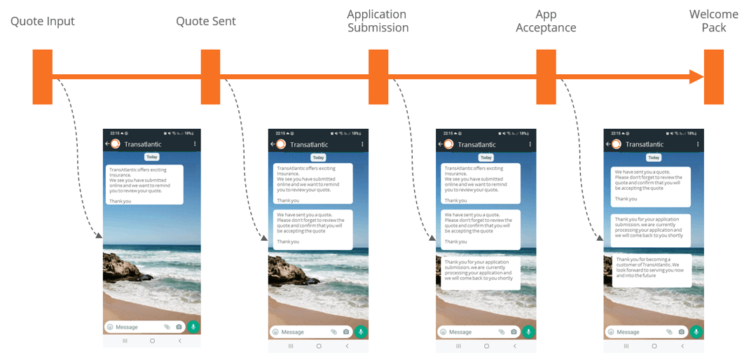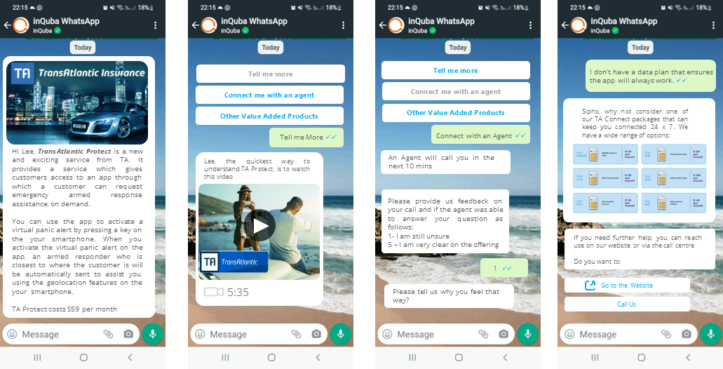
I have been in the journey orchestration industry for several years and every day we have the opportunity to engage with customers to share our experiences, learn from them and explore new possibilities. There is so much learning happening and I am absolutely passionate about this industry and I thought it would be useful to share some of those experiences with my network. The topic I want to start with is a fairly basic one centred around the idea of the difference between real and fake journey orchestration.
Communicating the Differences
We have recently had an experience with a client that is actively using our Journey Orchestration solution. The solution is working incredibly well and we are achieving incredible results. To give you a sense of the ROI, consider the following case studies:

Journey Orchestration ROIs
The client is a leading financial service provider and offers truly unique solutions to the market. We have an excellent relationship with them and they are enjoying really great ROI.
Enter the challenge : a provider that claims they can do it for 1/10th of the cost. There is no doubt it can be done more cheaply but will the same ROI be achieved – no it won’t! So what is the difference between a solution that sends some messages and one that truly does journey orchestration. It is this dilemma that led me to write this article.
Faking It
Lets consider a scenario of a financial institution wanting to nudge customers along the journey. The diagram below shows how this is possible:

Faking it
It is true to saying that the above approach will result in:
- An improvement in conversion on the customer journey
- A more informed customer
- A rapid (and cheap) implementation
It is also true to say that the above approach will have a net positive impact and might meet the need of many customers. However, if you really want to get 1000%+ ROIs, you are going to need an alternative approach
Real Customer Journey Orchestration
Lets look at the same scenario with a full blown Journey Orchestration Approach. This looks quite different:

It is supported by rich dialogues – an example is shown below:

Rich Interactive Journey Dialogues
There are several components you should demand of anyone claiming to offer a journey orchestration solution:
- Single View – If there is no single view, there is no journey – it is a messaging solution
- Interactive Visualisation of the Customer Journey – your solution provider should be able to show you in real-time the paths that customer are taking
- Deep Insights about How the Customer Feels – Feedback collected along the customer journey is key to understanding the customer motivation along the journey
- Dynamic Personalisation – the messaging should both remember everything about the customer along the journey and adjust the journey as a result
- Reports of Goal Completion and Drop Offs – the key objective of a customer journey is to support the customer helping them getting their job done. If they get that right, there is success, if not (a drop off), there is failure
- Overlayed Clustered Text Comments on the Journey – Understanding what the customer is doing is half the battle won – understanding how they feeling is a fundamental building block to higher ROIs
- Nudging Based on Inaction – A key challenge to traditional CX thinking is that if there is a really easy journey, customers will move forward. Our experience shows that customer must be nudged by digital messages or people to get them to complete the journey
- Segmenting Customers for Analysis and Personalisation – Understanding groups of customers that have different contexts and therefore challenges is another key element required for higher ROIs
- Being Able to Drill Down and Explore Specific Customers and their Specific Journeys – the ability drill down into the actions of each customer helps bring the story alive in understanding goal achievement or drop off
- The Ability to Implement Quickly with Standard Integrations – It is generally true to say that anything can be built from the ground up but custom coding and long running IT projects massively detract from the ROI
The above list is not comprehensive, but it is a great starting point for considering the difference between a journey orchestration solution and a solution that messages customers at various points in the customer journey.
Our experience has proven that the comprehensive approach yields multiple the value of a simple messaging solution (and yes, it costs more but the ROI is far far greater).
The area of customer journey orchestration is filled with interesting learnings in a world where marketing comes together with data (and lets not forget AI).
I look forward to sending out a learning on a weekly basis – please reach out and feel free to debate the points – while we have extensive experience, the field is a relatively new one and we are all learning on a daily basis.
Connect with us
Find out how inQuba can help you transform your customer engagement strategy.
About inQuba Journey Management
Customer Journey Management is revolutionizing how businesses engage with their customers. Like a precision tool, it offers targeted, data-driven insights into specific customer cohorts, behaviors, and use cases, allowing you to act with accuracy and purpose. Unlike traditional CX approaches, which can sometimes yield flat results, our Journey Management solution combines Journey Analytics and Journey Orchestration to deliver a comprehensive view of your customers’ actual journeys.
With inQuba, you can visualize real customer journeys, understand the emotional drivers behind their actions, dynamically remove obstacles, and provide timely, personalized nudges to guide them toward desired outcomes. This strategic approach has proven to double customer conversion rates, transforming both customer experiences and business growth.
We’d love to learn more about your business challenges and discuss how inQuba Journey Management can empower your organization to achieve its goals. Reach out today to find out how we can assist you.



